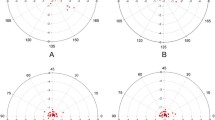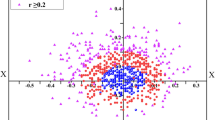Abstract
Purpose
To evaluate the effects of different programmed optical zones (POZs) on achieved corneal refractive power (CRP) with myopic astigmatism after small incision lenticule extraction (SMILE).
Methods
In total, 113 patients (113 eyes) were included in this retrospective study. The eyes were divided into two groups according to POZ: group A (6.5, 6.6, and 6.7 mm, n = 59) and group B (6.8, 6.9, and 7.0 mm, n = 54). Fourier vector analysis was applied to evaluate the error values between the attempted and achieved corneal refractive power (CRP). Alpins vector analysis was used to calculate surgically induced astigmatism (SIA), difference vector (DV), magnitude of error (ME), and astigmatism correction index (ACI). Multivariate regression analysis was performed to assess potential factors associated with the error values.
Results
The error values in the group with large POZ were closer to zero, and significantly associated with the POZ at 2 and 4 mm of the cornea (β = − 0.50, 95% confidence interval [CI] [− 0.80, − 0.20]; β = − 0.37, 95% CI [− 0.63, − 0.10], P < 0.05, respectively). For the correction of astigmatism, the values of SIA, ME, and ACI were lower in group B than in group A (P < 0.05). The fitting curves between TIA and SIA were y = 0.83x + 0.19 (R2 = 0.84) and y = 1.05x + 0.04 (R2 = 0.90), respectively.
Conclusions
Smaller POZs resulted in higher error values between the achieved- and attempted-CRP in the SMILE procedure, which should be considered when performing surgery.


Similar content being viewed by others
References
Kim TI, Alió del Barrio JL, Wilkins M, Cochener B, Ang M (2019) Refractive surgery. Lancet 393:2085–2098. https://doi.org/10.1016/So140-6736(18)33209-4
Primavera L, Canto-Cerdan M, Alio JL, del Barrio JLA (2022) Influence of age on small incision lenticule extraction outcomes. Br J Ophthalmol 106:341–348. https://doi.org/10.1136/bjophthalmol-2020-316865
Liu J, Wang Y (2020) Influence of preoperative keratometry on refractive outcomes for myopia correction with small incision lenticule extraction. J Refract Surg 36:374–379. https://doi.org/10.3928/1081597X-20200513-01
Torky MA, Alzafiri YA (2017) Visual and refractive outcomes of small-incision lenticule extraction in mild, moderate, and high myopia: six-month results. J Cataract Refract Surg 43:459–465. https://doi.org/10.1016/j.jcrs.2017.01.015
Shin DH, Lee YW, Song JE, Choi CY (2020) Comparison of refractive outcomes after photorefractive keratectomy with different optical zones using Mel 90 excimer laser. BMC Ophthalmol 20:270. https://doi.org/10.1186/s12886-020-01537-3
Shetty R, Francis M, Shroff R, Pahuja N, Khamar P, Girrish M et al (2017) Corneal biomechanical changes and tissue remodeling after SMILE and LASIK. Invest Ophthalmol Vis Sci 58:5703–5712. https://doi.org/10.1167/iovs.17-22864
Woodcock M, Shah S, Mandal N, Pieger S, Grills C, Moore TBC (2013) Small optical zones with aspheric profiles in laser refractive surgery for myopia: a surgical outcome and patient satisfaction study. Cont Lens Anterior Eye 36:259–264. https://doi.org/10.1016/j.clae.2013.02.010
Wu Y, Huang Z (2021) Comparison of early visual quality in patients with moderate myopia using different optical zones in small incision lenticule extraction (SMILE). BMC Ophthalmol 21:46. https://doi.org/10.1186/s12886-020-01798-y
Moshirfar M, Huynh R, Bundogji N, Tukan AN, Sant TM, McCabe SE et al (2021) Comparison of 6.0 mm versus 6.5-mm optical zone on visual outcomes after LASIK. J Clin Med 10:3776. https://doi.org/10.3390/jcm10173776.
Milivojević M, Petrović V, Vukosavljević M, Marjanović I, Resan M (2016) The assessment of the stability of the corneal structure after LASIK correction of myopia by different optical zone diameters. Vojnosanit Pregl 73:572–576. https://doi.org/10.2298/vsp140627029m
Wu D, Wang Y, Zhang L, Wei S, Tang X (2014) Corneal biomechanical effects: small-incision lenticule extraction versus femtosecond laser-assisted laser in situ keratomileusis. J Cataract Refract Surg 40:954–962. https://doi.org/10.1016/j.jcrs.2013.07.056
Gyldenkerne A, Ivarsen A, Hjortdal JØ (2015) Assessing the corneal power change after refractive surgery using Scheimpflug imaging. Ophthalmic Physiol Opt 35:299–307. https://doi.org/10.1111/opo.12202
Holladay JT, Moran JR, Kezirian GM (2001) Analysis of aggregate surgically induced refractive change, prediction error, and intraocular astigmatism. J Cataract Refract Surg 27:61–79. https://doi.org/10.1016/s0886-3350(00)00796-3
Liu S, Gu X, Zhang X, Zhao J, Zhou X (2022) Achieved and functional optical zone in myopic eyes with high astigmatism after small incision lenticule extraction. J Refract Surg 38:243–249. https://doi.org/10.3928/1081597X-20220201-01
He S, Luo Y, Chen P, Ye Y, Zheng H, Lan M et al (2022) Prospective, randomized, contralateral eye comparison of functional optical zone, and visual quality after SMILE and FS-LASIK for high myopia. Transl Vis Sci Technol 11:13. https://doi.org/10.1167/tvst.11.2.13
Zhang JH, Wang SR, He YX, Yao BY, Zhang Y (2020) The best optical zone for small-incision lenticule extraction in high myopic patients. J Cataract Refract Surg 46:1302–1307. https://doi.org/10.1097/j.jcrs.0000000000000282
Ma J, Wang Y, Wei P, Jhanji V (2018) Biomechanics and structure of the cornea: implications and association with corneal disorders. Surv Ophthalmol 63(6):851–861. https://doi.org/10.1016/j.survophthal.2018.05.004
Munnerlyn CR, Koons SJ, Marshall J (1988) Photorefractive keratectomy: a technique for laser refractive surgery. J Cataract Refract Surg 14:46–52. https://doi.org/10.10116/s0886-3350(88)80063-4.
Chow SSW, Chow LLW, Lee CZ, Chan TCY (2019) Astigmatism correction using SMILE. Asia Pac J Ophthalmol (Phila) 8:391–396. https://doi.org/10.1097/01.APO.0000580140.74826.f5
Damgaard IB, Ang M, Mahmoud AM, Farook M, Roberts CJ (2019) Functional optical zone and centration following SMILE and LASIK: a prospective, randomized, contralateral eye study. J Refract Surg 35:230–237. https://doi.org/10.3928/1081597X-20190313-01
Alió del Barrio JL, Vargas V, Al-Shymali O, Alió JL (2017) Small incision lenticule extraction (SMILE) in the correction of myopic astigmatism: outcomes and limitations - an update. Eye Vis (Lond) 4:26. https://doi.org/10.1186/s40662-017-0091-9
Pan C, Tan W, Hua Y, Lei X (2019) Comprehensive evaluation of total corneal refractive power by ray tracing in predicting corneal power in eyes after small incision lenticule extraction. PLoS One 14:e0217478. https://doi.org/10.1371/journal.pone.0217478.
Oh JH, Kim SH, Chuck RS, Park CY (2014) Evaluation of the Pentacam ray tracing method for the measurement of central corneal power after myopic photorefractive keratectomy. Cornea 33:261–265. https://doi.org/10.1097/ICO.0000000000000034
Acknowledgements
The authors gratefully acknowledge the funding support from the National Natural Science Foundation of China and the Key Projects of Science and Technology Fund of Tianjin Health and Family Planning Commission.
Funding
This work was supported by the National Program on Key Research Project of China (YW:2022YFC2404505), the Tianjin Diversified Investment Fund for Applied Basic Research (YW: 21JCZDJC01190), the Tianjin Health and Technology Project (YW: TJWJ2022XK036), the Key Projects of Science and Technology Fund of Tianjin Health and Family Planning Commission (QF: 2014KR17), and the Tianjin Key Medical Discipline (Specialty) Construction Project (TJYXZDXK-016A).
Author information
Authors and Affiliations
Contributions
The corresponding author, Professor Yan Wang, contributed to the conception and design. Material preparation, data collection, and analysis were performed by HZ and XZ. The first draft of the manuscript was written by HZ and XZ. LX, JZ, QF, and LZ commented on previous versions of the manuscript. YW and TCYC revised and approved the final manuscript.
Corresponding author
Ethics declarations
Conflict of interest
Haohan Zou, Xinheng Zhao, Lulu Xu, Jiamei Zhang, Qian Fan, Lin Zhang, Tommy C.Y. Chan, and Yan Wang declare that they have no competing interests. There are no competing interests regarding the equipment used in this study.
Ethical approval
This study was registered in the Clinical Trial Register (NCT05017376), approved by the Ethics Committee of Tianjin Eye Hospital, and conducted in accordance with the Declaration of Helsinki.
Consent to participate
The ethics committee waived the requirement for informed consent, given the retrospective nature of data collection and the use of anonymized data.
Additional information
Publisher's Note
Springer Nature remains neutral with regard to jurisdictional claims in published maps and institutional affiliations.
Supplementary Information
Below is the link to the electronic supplementary material.
Rights and permissions
Springer Nature or its licensor (e.g. a society or other partner) holds exclusive rights to this article under a publishing agreement with the author(s) or other rightsholder(s); author self-archiving of the accepted manuscript version of this article is solely governed by the terms of such publishing agreement and applicable law.
About this article
Cite this article
Zou, H., Zhao, X., Zhang, J. et al. The effects of programmed optical zones on achieved corneal refractive power with myopic astigmatism after small incision lenticule extraction (SMILE): a vector analysis. Int Ophthalmol 43, 2493–2501 (2023). https://doi.org/10.1007/s10792-023-02649-7
Received:
Accepted:
Published:
Issue Date:
DOI: https://doi.org/10.1007/s10792-023-02649-7




